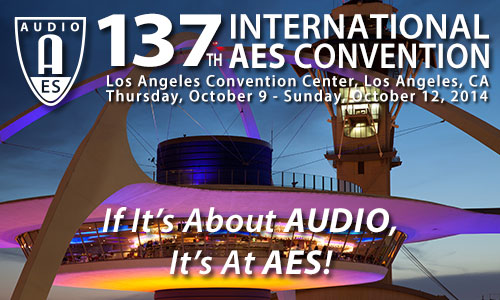
AES Los Angeles 2014
Engineering Brief EB4
EB4 - eBriefs—Papers Session 2
Saturday, October 11, 11:30 am — 1:00 pm (Room 309)
Chair:
Eric M. Benjamin, Surround Research - Pacifica, CA, USA
EB4-1 SoundWire: A New MIPI Standard Audio Interface—Pierre-Louis Bossart, Intel Corporation - Austin, TX; Juha Backman, Microsoft - Espoo, Finland; Jens Kristian Poulsen, BlackBerry - Waterloo, ON, Canada
This paper presents the key features of the upcoming SoundWire hardware interface and protocol. SoundWire is a robust, scalable, low complexity, low power, low latency, two-pin (clock and data) multi-drop bus that allows for the transfer of multiple audio streams and embedded control/commands. SoundWire provides synchronization capabilities and supports both PCM and PDM, multichannel data, isochronous and asynchronous modes. The development of this interface has generated a lot of interest and contributions from providers of audio peripherals (microphones, amplifiers & audio codecs), silicon vendors and OEMs. It will become a ratified standard by MIPI (Mobile Industry Processor Interface consortium) at the end of 2014. The first products should appear in 2015 and enable new usage models or design choices for audio applications.
Engineering Brief 172 (Download now)
EB4-2 Performance and Response: A Framework to Discuss the Quality of Audio Systems—Ron Bakker, Yamaha Music Europe - Vianen, Netherlands; Masahiro Ikeda, Yamaha Corporation - Hamamatsu, Shizuoka, Japan; Sungyoung Kim, Rochester Institute of Technology - Rochester, NY, USA
Recently we have designed a new networked digital audio system that is far more flexible yet complicated than before. A main design parameter was sound quality, focusing on cognitive judgment as well as physical quality since they both significantly influence the final sound quality evaluation. To adopt a human centric based approach for the design of a flexible networked digital audio system, the authors redefine the concept of sound quality assessment that classifies a system’s overall quality into two attributes: a physical part as performance and a cognitive part as response.
Engineering Brief 173 (Download now)
EB4-3 Analog Mixer Digitally Controlled via Plugin—Vasin Limsukhawat, Max Sound Contour - Denver, CO, USA; University of Colorado at Denver
The purpose of this project is to turn an old analog mixer to be more controllable which enhances the workflow to be more efficient. It consists of two major components: hardware and software. A microcontroller has been used to control the motorized potentiometer as well as transfer all the data from the mixer to the plugin or vice versa. This provides an ability to control the mixer via the AU plugin or manually adjust as well as save and recall presets.
Engineering Brief 175 (Download now)
EB4-4 Performance of the Microphone-Preamp Interface—Eric M. Benjamin, Surround Research - Pacifica, CA, USA; Andrew Kimpel, AURALab - San Francisco, CA, USA
The microphone/preamp interface is very important but not as well understood as its importance would suggest. The signal level between the microphone and the preamp is at the lowest level it will ever be. Furthermore, any degradation or loss of quality can’t be restored by later processing. The microphone, microphone cable, and preamplifier are made by different companies. The power for the microphone comes from the preamplifier. To optimally design the preamplifier it would be desirable to know the signal levels and the output impedance of the microphone. Also, the output impedance of the microphone affects the intrusion of external electrical noise into the system. A survey and study of the interface yields new insights into system performance.
Engineering Brief 176 (Download now)
EB4-5 Removal of Partially Correlated Noise to Improve Signal to Noise Ratio—A Theoretical Study—Simon Busbridge, University of Brighton - Brighton, UK; Chris Garrett, University of Brighton - Brighton, UK
Time correlation and decorrelation are well established tools to improve the signal to noise ratio of a system, yet they are often poorly understood. When several unwanted signals are correlated they are much easier to remove from uncorrelated wanted signals than vice versa, where a much poorer improvement is possible. A case in point is the removal of wind noise from microphone signals. The situation is further compounded when one or other of the signals is only partially correlated or different spectral content is differently correlated. This paper looks at the theoretical improvement in signal to noise ratio when either the signal or the noise are correlated to different degrees. Application to real signals and noise is discussed.
Engineering Brief 177 (Download now)
EB4-6 Dynamic Audio Imaging In Radial Virtual Reality Environments—Mark Blewett, University of Illinois at Chicago - Chicago, IL, USA; James Pinkl, University of Illinois at Chicago - Chicago, IL, USA; Bryan Dalle Molle, University of Illinois at Chicago - Chicago, IL, USA
The CAVE2 is a large scale, 320 degree, 3D / 2D
virtual reality environment featuring motion capture technology and located in the Electronic Visualization Laboratory at the University of Illinois at Chicago. The environment includes a 20.2 channel sound system controlled by a SuperCollider based audio server that is, in turn, controlled via the proprietary Omicron SoundAPI. Audio imaging for the system had operated with the assumption that the listener was stationary in the center of the CAVE2 and spatial extent was not
dynamically altered. Our team added functionality to maintain audio imaging, including source position and width, as a tracked user and sound object move relative to one another within the environment.
Engineering Brief 162 (Download now)
